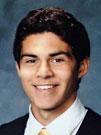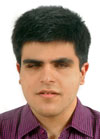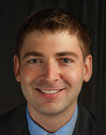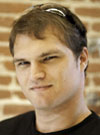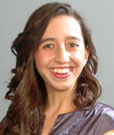| |
|
|

|
|
ATLAS |
|
|
Assistive
Technology
Laboratory
at
Stanford |
|
|
|
Technology
and design benefitting individuals with disabilities and older adults in the
local community |
January 15, 2016 |
|
|
|
|

Perspectives is the newsletter of the
Stanford course,
Perspectives in Assistive
Technology.
This issue invites you
to attend the next class session and
encourages your participation in the
course's assistive technology faire.
Perspectives in Assistive Technology is a Winter
Quarter Stanford course - now in its tenth year - that explores the design,
development, and use of assistive technology that benefits people with
disabilities and older adults. The schedule
consists of semi-weekly classroom discussions; lectures by
notable professionals, clinicians, and assistive technology users; tours
of local medical, clinical, and engineering facilities; an assistive
technology faire; and a film screening.
Next class
session - Tuesday, January 19th at 4:30pm (new starting time):
Perspectives of Stanford Students
with a Disability
Edan Alexander Armas,
Kartik Sawhney, Dan Berschinski, Jacob Gowan, and Zina Jawadi
|
Abstract: In this panel discussion, several
Stanford students with disabilities will discuss their disabilities, the
challenges they have faced, their academic goals, and the assistive technology
they use to be successful students. |
|
Edan Armas' Biosketch: "Coming from a boring
suburban town in Illinois, I'm so stoked to be able to be here at Stanford in
order to pursue my interests and send palm tree-ridden postcards to my jealous
siblings. I've worn hearing aids since second grade, but for most of my teenage
life, they were hidden under the warm embrace of my enormous Afro. The ladies
loved it. However, now short-haired and a little more mature, my hearing aids
are a great source of pride for me, and I hope to one day participate in
helping make hearing aid in general become more affordable and accessible to
people of all socioeconomic backgrounds. Stanford is the place to be, and I'm
ready to walk the path that this beautiful school is constantly in the process
of making for me." |
|
Kartik Sawhney's Biosketch: "I am a junior at
Stanford University, majoring in Computer Science with a focus on Artificial
Intelligence and Human Computer Interaction. I feel strongly about universal
access to virtual resources, and have been involved in several accessibility
and assistive technology projects with non-profits and tech giants including
IBM Research India,
Microsoft Research
India, Xavier's Resource Center for the
Visually Challenged, among others. At the same time, I'm intrigued by the
immense potential of artificial intelligence, and hope to further develop my
knowledge and skills in the field." Kartik's Virtual
Space |
|
Dan Berschinski's Biosketch: Dan
Berschinski grew up in Peachtree City, Georgia. In 2007 he graduated from
the United States Military Academy at West Point, with a commission in the
infantry. Upon graduation from West Point, Dan served as a rifle platoon leader
with the 5th Brigade, 2nd Infantry Division based out of Fort Lewis in
Washington State. In the summer of 2009, then Lieutenant Berschinski and his
men deployed to Afghanistan's violent Arghandab River Valley. On August 18th,
First Lieutenant Berschinski was severely wounded while leading his platoon on
a dismounted patrol. He triggered an improvised explosive device, which
instantly severed both of his legs above the knees, broke his jaw, and
shattered his left arm.
After being medically
evacuated out of Afghanistan, Dan underwent four months of inpatient surgeries
and hospitalization at Walter Reed Army Medical Center in Washington, DC. He
then spent the next three years undergoing daily physical therapy and
prosthetic limb training. He has since become the military's first
above-the-knee and hip-disarticulation amputee to walk on a daily basis. While
in therapy, Captain Berschinski served as a certified peer visitor, frequently
visiting and counseling other wounded service-members and their families. He
has also been an advocate for improved bomb-blast protective equipment for
troops currently in combat, as well as an advocate for patient care and
improved rehabilitation practices at Walter Reed.
After medically
retiring from the Army, Dan moved to Washington, DC. While in the Capital, he
founded Two-Six Industries, a
plastic product distribution company. He also became a board member of the
Amputee Coalition, America's
leading non-profit amputee awareness organization, as well as a board member of
the West Point Society of DC.
Dan currently resides in California, where he is
pursuing a Master of Business Administration degree at Stanford
University. |
|
Jacob Gowan's Biosketch: Jacob Frank Gowan
is majoring in mechanincal engineering (BS in 2014 and MS expected in 2016),
plays football and rugby, and is a Product Realization Lab Course
Assistant. |
|
Zina Jawadi's Biosketch: Zina is a
sophomore at Stanford University and the President of the
Hearing Loss Association of America,
California State Association, an affiliate of the Hearing Loss Association
of America, the largest nonprofit representing people with hearing loss in the
US. She also founded the Disability Awareness Program at her high school, The
Harker School, and previously researched and created a video about teaching
techniques for mainstreamed students with hearing loss.
|
|
Attend a lecture -
Course lectures will be held on Tuesdays
and Thursdays from 4:30 to 5:50pm and are open
to the greater Stanford community. You are most welcome to sit in on class
sessions that interest you. You need not be a Stanford student and there is no
required signup, enrollment, or charge. The class will meet in a large, tiered,
accessible classroom on campus in the Thornton Center, adjacent to the Terman
Fountain and near the Roble Gym, the same venue as last year. Here are the
parking options, maps, and directions to
the classroom. |
 |
|
|
Did you miss a
lecture? - Course lectures are posted on YouTube. To find the links,
browse to the Lecture Schedule webpage,
scroll down and click on the lecture of interest. Near the bottom of the page
you will see the Lecture Material section which has links to the slides,
photos, weblinks, and lecture video. |
 |
|
|
Participate in the Assistive
Technology Faire - This fourth annual course event will once again
provide an opportunity for students and community members to get an up-close
look at a variety of assistive technology devices and learn about available
services. Users of assistive technology products as well as small
companies and agencies serving individuals with disabilities and
older adults are encouraged to bring assistive technology devices and
information to display, demonstrate, and discuss. Please browse to the
Call for Assistive Technology Faire Participants
webpage and contact the course instructor if you would like to be a part of
this event as a user or vendor of assistive technology products or services.
Everyone is welcome to attend the Faire.
The Faire starts at 4:30pm on Thursday, February 4th just outside
the classroom, Thornton
110.
Here are photos
from last year's event. |
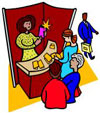 |
|
|
Upcoming community
event: |
|
|
Would you like to support the
course? - Funding in any amount for the course and student projects
is always welcomed. Monetary gifts support approved project expenses,
administrative costs, honoraria for guest lecturers, and the end-of-term
celebration. Refer to the Team Project Support
webpage for more information.
Do you have a question,
comment, or suggestion? - If you have general questions, comments,
or suggestions about the course, David L. Jaffe, MS, the instructor, can
be reached by email or at
650/892-4464. Thank you again for your interest in the course.
Dave
|

To unsubscribe from this newsletter, please email
Dave. |
|



